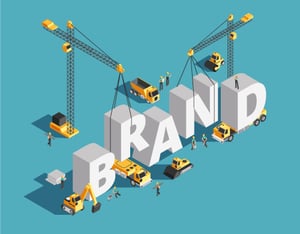6 Step Guide on a Successful Industrial Brand Development Strategy
Branding … not everyone’s favorite task to tackle on a Monday morning—or any day, for that matter—especially for industrial companies. We understand that getting the presses rolling and meeting production schedules out-prioritizes talks of re-branding on the daily. Besides, business looks good, the pipeline is full, and you have all you can handle with orders … for now. But relying on your high-quality products and exceptional service may only get you so far into the future.
 Unfortunately, in today’s digitally driven commerce model, simply relying on your company’s outputs can leave you steps behind as customers and competitors keep up with the many advancements available to them. If you aren’t out there with them—with contemporary, consistent messaging and a fresh look, you will be outpaced and outdated in no time. In fact, you may already be. There are just too many companies—easily accessible to customers—competing for market share on the same products to not have your brand serving as a quality differentiator. Sure, you have to keep delivery schedules on track, but you also need to keep an eye towards longevity. With any business, the ultimate goal should be sustainable growth—and a powerful brand can help with the heavy lifting in achieving this outcome.
Unfortunately, in today’s digitally driven commerce model, simply relying on your company’s outputs can leave you steps behind as customers and competitors keep up with the many advancements available to them. If you aren’t out there with them—with contemporary, consistent messaging and a fresh look, you will be outpaced and outdated in no time. In fact, you may already be. There are just too many companies—easily accessible to customers—competing for market share on the same products to not have your brand serving as a quality differentiator. Sure, you have to keep delivery schedules on track, but you also need to keep an eye towards longevity. With any business, the ultimate goal should be sustainable growth—and a powerful brand can help with the heavy lifting in achieving this outcome.
Your brand is an opinion maker—whether you like it or not. Having a strong brand presence will do wonders for your status in the same way a weak one can drag down your company’s standing. Would you want to do business with a company you perceived as out of touch and irrelevant? Probably not. To rev up your brand or create a successful new one, it’s time to put some serious effort into your brand development process—here are 6 easy steps to get you started!
6 Brand Development Steps
- Research Your Target Market
The first step of any brand development process is to determine the target audience you want to reach with your brand. You won’t be able to please everyone, so it’s important to cater your brand’s mission and messaging to the exact needs of the people who are the perfect customer for your business. Professional market research is the only way to determine you audience’s likes/dislikes, what their challenges are, and how you can help them. The narrower the focus, the more effective your branding becomes. The key here is to get specific; you need figure out the detailed behaviors and lifestyle of your customers. At the end of your research, compile all of your data and use it to build accurate buyer personas—which will not only help you in developing your brand messaging, but will aide in any future marketing activities.
If you are a start-up company, you will already have done your due diligence to ensure there is, indeed, a target market audience and need for your product or service. With rebranding efforts, your target market should be established and very well known to you. That is, of course, unless you are entering a new market, manufacturing new parts, or providing a different service. All this research gives you a blueprint for how to effectively reach them “where they live” in terms of what your brand can do for them.
Here’s an important distinction: your company brand needs to be “loyal” to your company’s story and its promise (and consistent delivery). Keep in mind, the brand identity comes from your company—not from the target audience. Your job here is to make the connection in your messaging between your brand and your target market’s needs. Here’s an excerpt from another article we wrote on rebranding your industrial company:
A brand must identify who you are and “why” you are as a company—your mission and vision. When done effectively, it translates to people in a way that allows them to quickly identify who you are, and more importantly, answer their “why” they should work with you. Your brand identity allows you to then cater your messaging to fit that of the new industry or demographic.
- Establish Your Brand’s Positioning
Once you’ve determined who your target audience is, you are now ready to develop your brand’s positioning within your specific market place. Some important questions to ask during this phase of the brand development process are:
- How is your company different from the others in your space?
- Why should potential customers within your target audience choose to work with you?
- What is your unique selling proposition (USP)?
- What are the biggest strengths of your business?
This is your why—the reason your business exists and why you get up every morning to take part in it. Try to define your purpose in a way that extends past your product’s characteristics and the excellent service you provide. A positioning statement is typically three to five sentences in length and captures the essence of your brand. It must be rooted in reality—as you will have to deliver what you promise—but should also have an element of aspiration that points to the direction/goal your brand intends on attaining in the future.
- Develop Your Messaging Guidelines
Once your brand’s positioning is set, you now need to focus on how you’re going to deliver that message. Brand messaging is an overarching term used to describe the words used by your brand—whether that be on your website, social media accounts, or even through word-of-mouth. It’s the language that appears—consistently—on all the marketing materials you use to promote your business. Effective brand messaging guidelines should include the following:
- Your brand’s USP
- A detailed description of your target audience
- What your company stands for and its goals
- Your brand’s story
- The tone of voice that should be used when writing any communications for the brand—e.g., web copy snippets and sample social media posts
- Any wording or phrases that should never be used in brand messaging
As stated above, it’s important to maintain consistency in your messaging. Constantly changing your core messaging will create a disconnect and instills a level of mistrust with customers. People become loyal to your brand because they self-identify with it. If it isn’t identifiable anymore because your messaging is not congruent, you can easily lose them. According to Forbes, “Consistent brand presentation across all platforms increases revenue by up to 23 percent.”
- Create Your Name, Logo, and Tagline
 Creating a name, tagline, and logo for your company is the fun part of the brand development process. However, it’s not something you should engage in without applying careful thought—or even getting expert guidance with. For many companies that are performing a brand refresh, a name change is not usually necessary. If you are a new company, are undergoing a merger, or are burdened with an outdated or unsuitable name, then a new name may be the way to go.
Creating a name, tagline, and logo for your company is the fun part of the brand development process. However, it’s not something you should engage in without applying careful thought—or even getting expert guidance with. For many companies that are performing a brand refresh, a name change is not usually necessary. If you are a new company, are undergoing a merger, or are burdened with an outdated or unsuitable name, then a new name may be the way to go.
In regard to choosing an appropriate logo and tagline, keep it simple and relate it back to your story. Yes, keep your audience in mind, but remain true to your brand identity, legacy, and promise. Remember, your name, logo, and tagline aren’t your entire brand—they are just ways to identify and symbolize the values of your brand. Having a branding professional—someone with design expertise—explore designs with you is a sound option. Having new eyes on something old that you may be too close to often helps when rebranding or refreshing design elements.
- Launch Your Brand
With all of the above elements in place, it’s time to move forward and launch your brand. This means getting yourself out there, offering your services, and making a name for yourself or your new product. To promote the launch, actions such as implementing paid social media advertising, delivering email marketing blasts, attending trade shows, and distributing press releases through relevant industry publications will provide the means towards putting your new brand in front of the right eyes. Once your new brand is operational, give your audience time to respond to it. Sometimes a new brand can take a little while to be fully adopted, but have faith that in the long run, your brand’s personality will reach the appropriate people.
- Manage, Track, and Adjust
Your brand development process is far from over, even after your big launch. Brands must continuously evolve to keep up with the dynamic needs and desires of consumers. Don’t let your brand become stagnant, or you may be looking at starting this process all over again in a few years. Dedicate a team to constantly monitor your company’s reputation, conducting research to keep up with the evolution of your market; update your brand accordingly. Distribute surveys multiple times per year to gauge your target audience’s opinions of your brand at difference stages of your brand evolution. Tracking the entire process to ensure you’re drawing the right conclusions and making the correct adjustments.
Knowing Your Brand
If you’re concerned with your brand’s standing, then take a look at our Brand Report Card and see how you are doing. We work with many industrial manufacturers and have years of experience helping them navigate through our brand development process for brand “maintenance” and refreshing, along with full rebranding programs and brand strategies. Download the Brand Report Card to explore how authentically you connect with your company’s brand.


